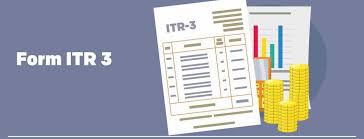The ITR-3 Form can be filed by those Individuals and Hindu Undivided Families who earn income from Proprietary business or by practising his/her profession. However, when an Individual/HUF earns income as a partner of a partnership firm which is carrying out business/profession, he cannot file ITR-3.
The ITR-3 form is specifically designed for individuals and Hindu Undivided Families (HUFs) engaged in business or profession, necessitating the maintenance of comprehensive books of accounts. This category encompasses professionals such as chartered accountants, doctors, lawyers, engineers, etc., whose income is calculated based on actual profits. Moreover, individuals earning from salaried employment and additional sources like freelancing or part-time business activities can also use the ITR-3 form to file their income tax returns.

What is ITR 3 Form?
The ITR 3 Form is crucial for taxpayers earning income from a business or a profession. It plays a vital role in the Income Tax Department’s efforts to collect comprehensive financial information, ensuring tax compliance.
Who can file ITR-3 Form?
- Carrying on a business or profession (both tax audit and non-audit cases)
- The return may include income from house property, salary/pension, capital gains and income from other sources.
- Remuneration received from a partnership firm
Who is Not Eligible to File ITR-3 Form?
An Individual or HUF who is earning income as a partner of a partnership firm which is engaged in a business/profession is not eligible to file ITR-3. In this case, he can file ITR 2
Due Date for Filing Form ITR3
The due date for filing the ITR Form 3, which is the income tax return, varies depending on whether the case is an audit case or a non-audit case for different assessment years:
- For Assessment Year 2023-24:
- Non-audit Cases: The due date is July 31, 2023
- Audit Cases: The due date is October 31, 2023
- These dates are subject to change by the income tax authorities, so it’s essential to stay updated with any revisions or extensions of the due dates.
Documents required for ITR 3 Form
- PAN (Permanent Account Number)
- Aadhaar Card
- Bank account details (account number and IFSC code)
- Form 16, if applicable (for salaried individuals)
- Details of your investments
- Books of accounts (if you have a business or professional income)
- Having these documents ready will make the ITR filing process smoother and more efficient.
Sections of the ITR 3 Form
- General Information: In this segment, you are required to provide your personal particulars, including your name, address, date of birth, email address, and PAN number. Additionally, you’ll specify the assessment year and indicate whether you are filing your return as a self-assessment.
- Income Details: This section necessitates the disclosure of your income from various sources, encompassing salaries, pensions, annuities, family pensions, and other avenues. You will also calculate your total taxable income and the corresponding tax liability.
- Deductions and Taxes Paid: In this category, you have the opportunity to claim deductions permitted under various sections of the Income Tax Act. Additionally, you must report the taxes you have paid during the financial year, such as advance tax and self-assessment tax.
- TDS/TCS Credit: This division mandates the inclusion of details regarding any Tax Deducted at Source (TDS) or Tax Collected at Source (TCS) credits that are applicable to you.
- Verification and Declaration: In this final section, you are tasked with validating your return through either a digital signature or by dispatching a physical copy of the signed return to the Centralized Processing Center (CPC). Moreover, you must make a declaration affirming that all the information furnished in the return is accurate and true to the best of your knowledge.
FAQs
What are the Different Methods of Filing ITR-3 Form?
- By filing a return electronically under digital signature. (Assessees who need to obtain a tax audit must use this method)
- By conveying the data in ITR-3 form electronically under electronic verification code.
- By transmitting the data in ITR-3 form electronically followed by the submission of return verification in
- Return Form ITR-V to Income tax office via mail. (Taxpayer filing ITR-3 form using this method must complete the acknowledgement in ITR-V.)
Late Filing Penalties for ITR3 Form?
- A late filing fee of ₹ 5,000 may be levied.
- If you file your return after December 31 of the assessment year:
- A late filing fee of ₹ 10,000 may be levied.
It’s important to note that the late filing fee may vary based on the taxpayer’s total income and other factors. Additionally, if your total income is less than ₹ 5 lakh, the maximum late filing fee is capped at ₹ 1,000. Therefore, it’s advisable to file your ITR form 3 on time to avoid these penalties and any potential legal consequences.
